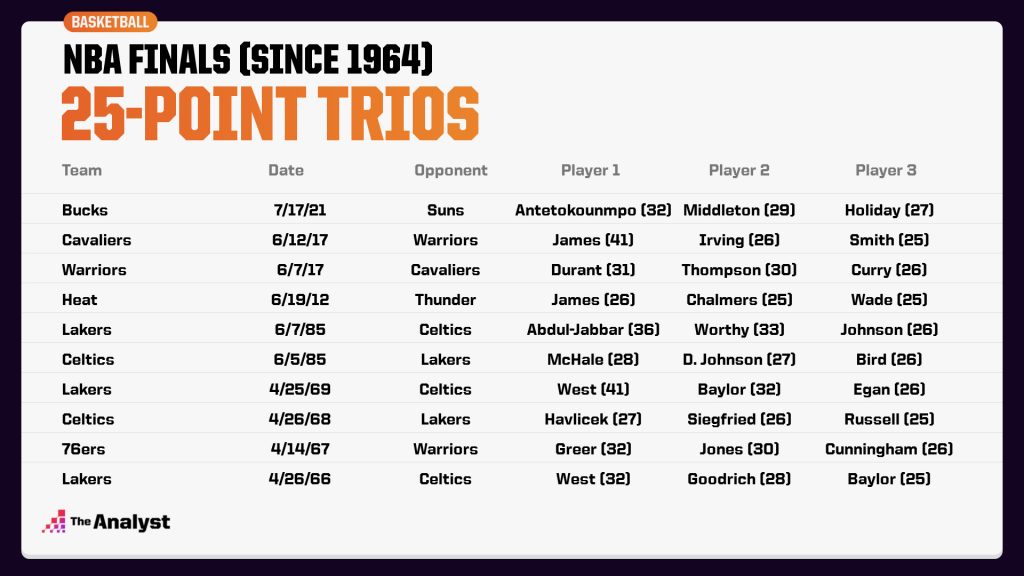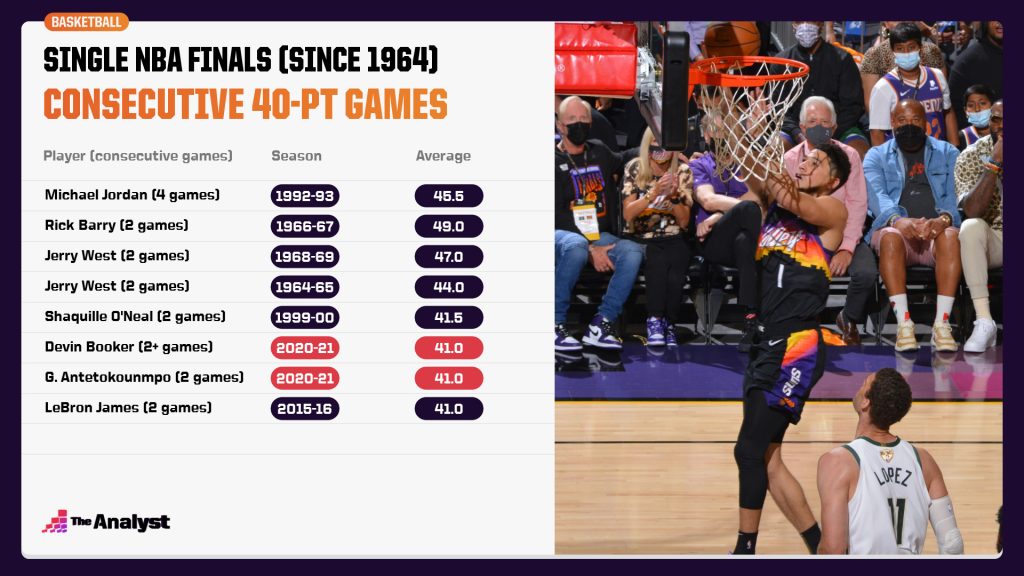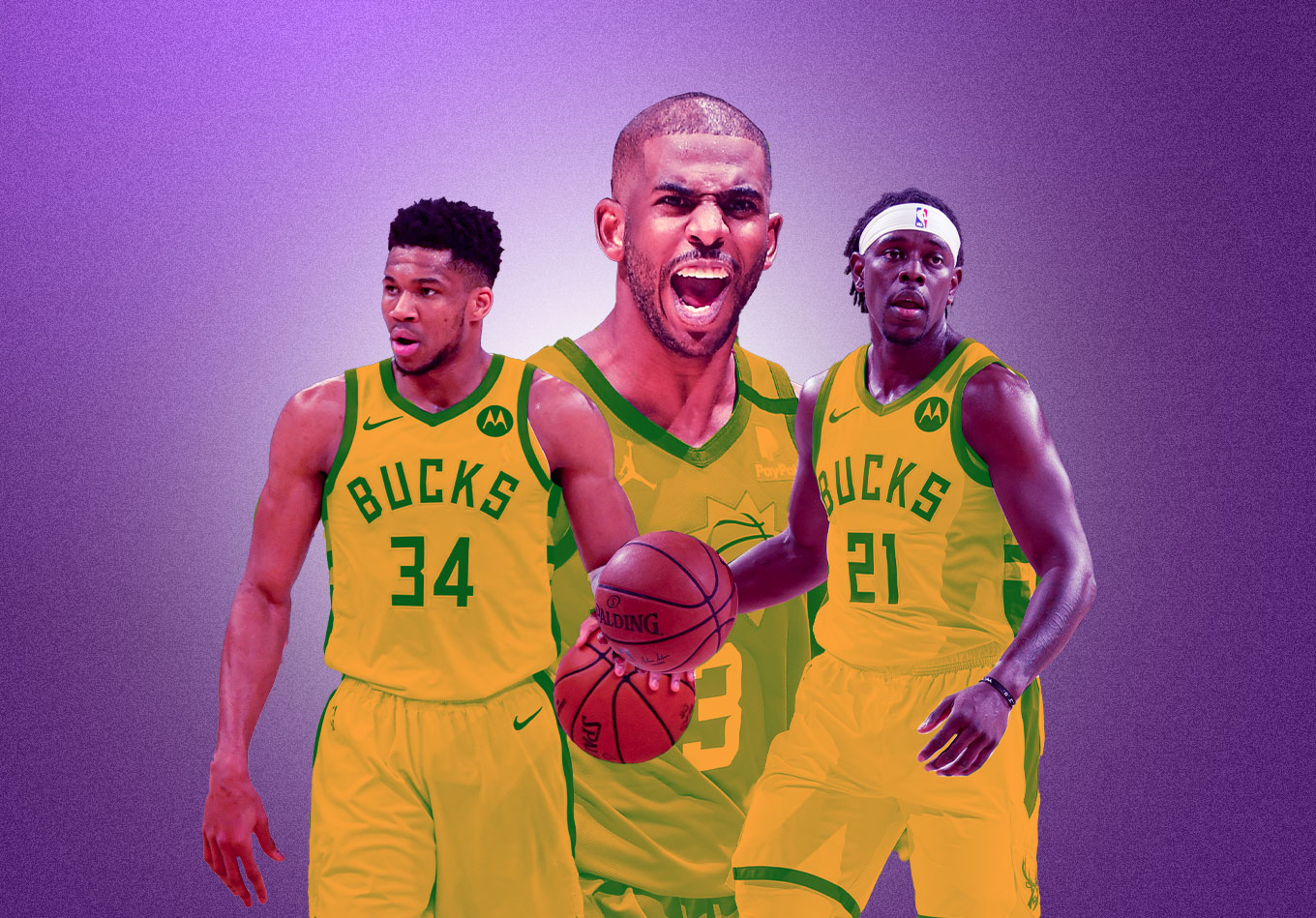Welcome to our daily NBA Finals blog where we try to make sense of what just happened, examine the key players and matchups, and identify any potential adjustments as the series progresses.
Postgame: After The Steal, The Pass and The Dunk, Is the Title Next for the Bucks?
The Block was the most significant defensive play in Milwaukee Bucks history for approximately 72 hours.
Make way for The Steal.
Jrue Holiday’s strip of Devin Booker with 17 seconds left ripped away Phoenix’s chance to take the lead after the Suns had trailed by 14 early in the fourth quarter, but that wasn’t the end of a career-defining performance for the most-maligned member of the Bucks’ Big Three. Instead of crossing halfcourt and waiting to get fouled, Holiday threw an alley-oop (The Pass!) to Giannis Antetokounmpo (The Dunk!), the last of his 13 assists and the final basket in Milwaukee’s heart-pounding, 123-119 Game 5 win.
Down 2-0 a week ago, the Bucks are suddenly in position to win their first title in 50 years Tuesday night on their home floor.
Antetokounmpo bullied his way to 41 points in Milwaukee’s Game 3 win, then Middleton provided the offensive fireworks (40) in Game 4 before Giannis’ eye-popping block on Deandre Ayton down the stretch. But Holiday joining the fray offensively for 48 minutes made the difference in a game where both teams seemed dead in the water at times. After shooting 33% in his first four Finals games, Holiday went 12 for 20 in Game 5, finishing with 27 points before capping it off with the biggest steal and assist of his life.
“It was the game for us all to get going, all three of us,” Antetokounmpo told ABC’s Malika Andrews on the floor after the game. “We played great basketball. Kept our composure when we were down 16, kept playing. It’s the NBA Finals, so you’ve got to give everything you’ve got, and that’s the team we have.”
Milwaukee led 108-94 after Holiday banked in a 9-foot jumper with 9:08 left, a turnaround that seemed impossible after the first 12 minutes. The Suns raced out to a 37-21 lead after one quarter before the Bucks blitzed Phoenix in the second quarter – largely with Antetokounmpo sitting on the bench. Holiday had 14 points and five assists in the second, and Milwaukee went on a 28-10 run as the two-time MVP rested to begin the quarter before carrying a 64-61 lead into halftime.
How rare was that quarter? No team in the NBA playoffs had trailed by 16 or more at the end of the first and gone on to lead at halftime since 1998.
It was Middleton’s turn to shine in the third, as he put up 11 points in the first 5:12 of the quarter – still not quite enough to match Booker, who poured in 12 of his game-high 40 in that same stretch. Middleton only had one basket in his next 15 minutes of game time before two enormous buckets in the final 3:30 – a 21-foot step-back jumper turned and-1 over Jae Crowder that put the Bucks up nine, then a step-back 3 to make it 120-112 with 2:23 to play.
Antetokounmpo (32), Middleton (29) and Holiday (27) are the sixth group of three teammates in the last 50 NBA Finals to score 25 points apiece, and they did it making a combined six free throws (Giannis went 1! … 2! … 3! … 4 for 11 from the stripe). Milwaukee’s Big Three did its work in the flow of the game, each making at least 12 field goals – the only trio to do that in a Finals game since 1964.

Booker had 40 points for the second straight game, and it’s the fourth consecutive contest in these Finals in which at least one player has put up that many. Giannis had back-to-back 40s in Games 2 and 3 and now Booker has done it in 4 and 5 – a feat that, as of a week ago, had happened only six times since the 1965 Finals.

You could look at the box score and think Booker had a significant amount of help – namely from Paul (21 points, 11 assists) and Ayton (20 points, 10 rebounds) but for the second straight game that wasn’t the case. Paul seemed bizarrely absent in the first three quarters, playing just 23 minutes despite not finding himself in foul trouble. Normally getting downhill in pick and roll and either finding his spot at the elbow or putting a perfect pass in a shooter’s pocket, he was high and wide on a number of looks to the corner and was just 2 of 7 in the paint prior to a fourth quarter in which he put up 10 points.
Ayton’s slips to the rims after screening Paul’s man up top, a play that seemed unstoppable in Game 1 and the first quarter of Game 3, have dried up. He got to the line six times in Game 5, but as Paul’s performance continues to slip – left wrist injury, general fatigue or whatever else may be ailing him – the Suns have done less and less to get Ayton involved offensively.
While Booker was clearly feeling it from the get-go in Game 4, he controlled the ball somewhat to the Suns’ detriment in this one. The Suns went 13 of 19 from 3-point range. That first number is good! The second is problematic. Phoenix went 5 of 6 from long distance in the first quarter and then settled for too many Booker 2s after long dribbling sequences thereafter. Booker made some absolutely ridiculous shots, but he has just eight assists in the last three games. The Suns have made 33 of 59 (55.6%) of their 3s in their last two home games. Jae Crowder, Mikal Bridges and Cam Johnson need to be involved for this offense to be at its best, and that didn’t happen after the first quarter in Game 5 as Booker dominated possession after possession – sequences that the Bucks were probably happy to let him have.
The Suns could easily go to Milwaukee and send this back to the desert for Game 7, but The Devin Booker Show – as amazing as it’s been on a number of occasions in these playoffs – probably isn’t the way for them to get there.
The Bucks might go as Giannis goes, but as these Finals have progressed, Holiday and Middleton have shown that they’re outstanding supporting actors capable of carrying the critical moments of a series.
–Brett Huston
Research support by Stats Perform’s Tim Bazer.
Pregame: Can the Suns Rediscover Their Groove Back in the Valley?
The Suns have had answers for every question thrown at them this season. Can Chris Paul and Co. solve their biggest problem yet as they head back home?
The sweeping discussions surrounding the Milwaukee Bucks during the regular season involved a seemingly revamped offense well-prepared for a deep playoff run.
More experimentation, improved counters against the Giannis Wall and an upgrade at point guard, swapping Eric Bledsoe for Jrue Holiday, were to coalesce for a more appropriate offense-defense balance ahead of the postseason.
Yet nearly two months into the playoffs, the Bucks find themselves touting a pedestrian offense (111.7 offensive rating) and stifling defense (106.4 defensive rating). Following a pair of home victories knotting the NBA Finals at 2-2, their defensive prowess was on full display. They confined the Phoenix Suns’ seventh-ranked regular-season offense to a 104.6 offensive rating, a stark decline from 119.8 in two series-opening wins.
Spearheading these efforts were Holiday and Giannis Antetokounmpo, two 2020-21 All-Defensive First Team honorees stamping their mark through contrasting facets. Holiday is the chief reason for Chris Paul’s reduced offensive footprint in Milwaukee. He’s applying a one-man full-court press, routinely confronting Paul upon his first touch, and has only allowed Paul to play two minutes without him on the floor over the past two games.
Between Holiday’s unrelenting persistence and the Bucks’ discovering late in Game 2 how a switch-heavy scheme without Brook Lopez could stymie Paul’s creation, he’s not been the virtuoso orchestrator present during the Suns’ wins.
In Phoenix, when Lopez switched, Paul manipulated the uncovered hardwood extended his way to foster rhythm for buckets; when Lopez played traditional drop coverage, Paul veered into patented mid-range pull-ups. The common theme bridging these triumphs was space, a virtue not conceded in recent games, both by Holiday and his contemporaries.
Whenever Paul receives the ball, Holiday, flanked by other bodies, is there to crowd him and prevent him from gathering a head of steam. He drilled an assortment of challenging shots in Game 3, but still coughed up four turnovers, while Game 4 saw him go 5-of-13 for 10 points and surrender five giveaways.
He’s tallied 15 turnovers over his past three games (six, four, five) and logged his three highest turnover outings of the playoffs (four is tied for his third-highest). There are fewer opportunities for him to maneuver as he pleases. The badgering defensive attention is accelerating his mapping of decisions to a detrimental rate and condensing chances to produce. His 14 and 13 shot attempts in successive games are his fewest since Game 2 against the Denver Nuggets – a 25-point rout.
Paul is a star who, since the dawn of his NBA career, so calmly and expertly dictates the pace of his actions. Milwaukee – with Holiday fastened at his hip and a switching approach that exploits his insufficient burst and diminutive stature into constrained creation – has breached his internal clock, turning the hands at its own preference. Game 4 was saturated with a whole lot of uncharacteristically hasty and inharmonious Chris Paul sequences.
Meanwhile, Giannis continues to assert himself as arguably the league’s most imposing stopper. He’s the best help defender in the NBA, spawning swathes of the court with bounding strides and a 7-foot-3 wingspan. The Bucks are switching him in ball screens, pegging him as the primary rim protector in their increasingly popular non-Lopez lineups and relying on him to erase perimeter breakdowns from their select contingent of porous on-ball options.
In the fourth quarter alone of Game 4, he checked all of these boxes, containing initiators, roaming as a ball hawk (two steals) and altering shots in the paint (two blocks). He’s been a spectacular defender through this playoff run. Wednesday’s final frame was a synthesis of his range, led by his defiance of gravity, movement patterns and defensive positioning on a game-altering rejection.
A counter for the Suns to unlock their scuffling offense and point guard could be to use guys with more ball skills and shooting than Deandre Ayton, a la Devin Booker, Mikal Bridges and Cam Johnson, as Paul’s screeners. Milwaukee has quelled much of Ayton’s interior scoring over the past seven quarters. By confronting him with size and physicality, the Bucks were able to slowly recover to him on the roll after screening for Paul because they’re unconcerned about his advantage passing and decision-making. He’s matured in this regard, but any dribble from Ayton remains a suboptimal play for the offense. Premier play-finishing is his expertise.
All three wings/guards mentioned are more threatening in space away from the rim and Phoenix has previously enjoyed success utilizing Booker as a pick man early in this series. This strategy could also be an avenue for Bridges to regain his footing after logging just 11 total points on eight shots in Milwaukee. The Bucks’ emphasis to bottle up early offense and transition play has predominantly disrupted Paul, but it’s also affected Bridges, who thrives on sprint-and-score opportunities on the break.
If the defense has to immediately consider the ripple effect of switching every screening action rather than having a buffer period to recover, that could pry open some passing and shooting lanes for Paul and ease the burden he’s enduring, while also revitalizing the third-year wing.
Although the Bucks have recently streamlined their defensive communication and execution to muddle Ayton’s rim-runs, he also failed to play with the zeal in Game 4 that’s come to define his 2021 breakout. He operated with grace rather than force, priorly a defining shortcoming of his offense. It reappeared Wednesday and was a primary contributor to a six-point, 3-of-9 performance, his worst scoring showing of these playoffs.
All these potential alterations – manufacturing more room for Paul to succeed, kickstarting Bridges into a flow, Ayton maximizing his size inside – fail to address the fact Phoenix has not yet contrived a means for curbing Giannis. Through four games, the two-time MVP is averaging 32.3 points, 14.0 rebounds, 5.5 assists, 1.8 steals and 1.5 blocks on 65.0% true shooting, including 87.5% of his looks at the rim, which compose 53.3% of his attempts. He’s crushing mismatches and Jae Crowder is being discarded on almost every mid-post face-up.
Only Ayton’s had a modicum of replicable prosperity against him, but the issue is that his minutes aren’t mirroring Giannis, who’s played 35 minutes sans Ayton in this series. The Suns were more scrupulous at home, with Ayton tracking Giannis for all but nine minutes. Yet road games represented a deviation when Giannis spent 26 minutes on the floor free from Ayton’s shadow. Some of that is due to Game 3 “foul trouble” (read here for more thoughts on that self-prescribed concept), though Giannis still benefited from eight non-Ayton minutes in Game 4.
When Ayton is on the floor, Giannis has a true shooting percentage of 62.6. When Ayton is on the bench, Giannis has a true shooting percentage of 73.0. Neither mark should qualify as “good” for the Suns, but the former is manageable, while the latter is an unsustainable championship path. Phoenix must meticulously align their minutes as closely as possible because Giannis is absolutely torching the small-ball units.
Milwaukee has the unimpeachable best player in this series. Phoenix probably needs to respond with the second- and third-best players. The past two games, that has not rung true and it’s the broadest relevant factor as to why these teams return to the desert each halfway toward a title.
The nuances of that dynamic will decide the remaining games.
–Jackson Frank
Design by Matt Sisneros.
Enjoy this? Subscribe to our newsletter to receive our selection of the best content of the week. It’s free.
